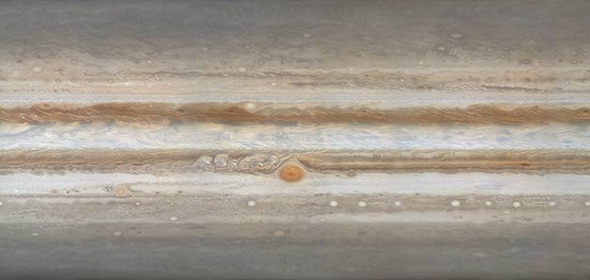Create a free profile to get unlimited access to exclusive videos, sweepstakes, and more!
Jupiter Unwrapped

On March 8, Earth lapped Jupiter in their race around the Sun. Earth orbits closer to the Sun than Jupiter, and so moves much more rapidly. Like a car on the inside track passing one on the outside, this meant that Earth was as close to Jupiter as it would be all year.
Astronomers call this event opposition, because it means the outside planet is opposite the Sun in the sky as seen from the inside planet. So, to us on Earth, Jupiter rose when the Sun set, was up all night, and appeared as big through a telescope as it would until the next opposition (which will be on April 1, 2017).
During the March opposition, planetary photographer extraordinaire Damian Peach aimed his 35 cm telescope skyward and shot video of the huge planet. Using software to pick and choose which frames minimized the blur of the atmosphere, he assembled the amazing image of Jupiter shown above. It “unwraps” Jupiter, mapping the spherical surface onto a rectangle. This distorts some of the features near the poles (like when a similar map of Earth makes Antarctica stretch all the way across the bottom, or magnifies how big Greenland is) but still gives a great overview of what’s what.
The most obvious feature is, of course, the Great Red Spot, a persistent storm that is at least four centuries old, and possibly far older. For reasons unknown, the Spot has been shrinking of late, but it’s still big enough to swallow the entire Earth without our planet touching the sides.
My favorite part of this image is the turbulence downstream of the Spot, as the circulating atmosphere flows around it. It’s much more apparent in the big version of this image, and I encourage you to take a look.
You can also see the banding of Jupiter, circulating weather systems that stretch all the way around the planet (you can find out all about this and more in my Crash Course Astronomy episode about Jupiter). Smaller pale circular storms dot the midlatitude southern hemisphere, and it’s easy to spot similar features all over the planet.
Using all the best frames from the observations over March 18 through 22, Peach created this stunning video of the monster planet rotating.
Jupiter spins once every 10 hours, so Peach had to match each image taken over five days carefully to get them to fit into the animation. It really gives an impression of the immensity of the planet; remember, 11 Earths would fit across Jupiter’s face!
Jupiter is always one of my favorite targets when I take my own telescope out. It’s big, easy to see (it’s the fourth brightest natural object in the sky, after the Sun, the Moon, and Venus), and the motions of its four biggest moons are easy to spot night after night, and sometimes in just a few hours.
Unfortunately it’s not well situated to observe now; it rises around 3:30 in the morning and sets in the afternoon. But starting in 2017 it’ll be gracing our early evening skies again, and I hope for a chance to take some time getting reacquainted with it. If you have an opportunity to see it—and many astronomy clubs have public star parties—I urge you to take it. Your view may not be as a good as Peach’s, but it hardly matters. Seeing a planet like Jupiter with your own eyes is an experience you won’t soon forget.
Take a look at Peach’s collection of Jupiter observations, as well as his website in general. Trust me: You’ll be glad you did.














